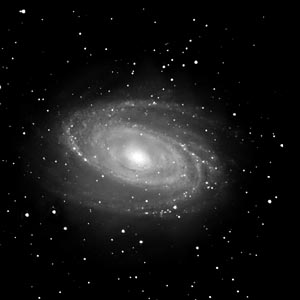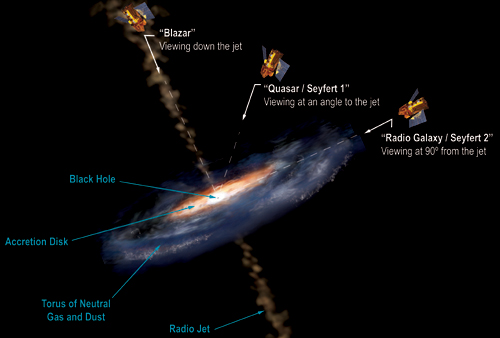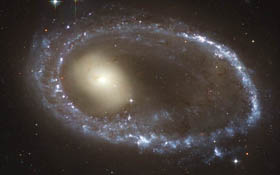galaxy

Figure 1. The spiral galaxy M81.

Figure 2. The different features of an active galactic nucleus (AGN), and how our viewing angle determines what type of AGN we observe. The extreme luminosity of an AGN is powered by a supermassive black hole at the center. Some AGN have jets, while others do not. Image credit: Aurore Simonnet, Sonoma State University.

Figure 3. The ring galaxy AM 0644-741. Hubble image.
A galaxy is a large system of stars, along with interstellar material and (at least in some cases) dark matter, that is held together by mutual gravitational attraction. There are three basic types: the spiral galaxy (Figure 1), the elliptical galaxy, and the irregular galaxy, with masses ranging from about 100,000 solar masses in the case of the smallest dwarfs to several trillion solar masses in the case of the largest ellipticals. A lenticular galaxy is midway in form between a spiral and an elliptical. Galaxies range in size from the smallest dwarf galaxies only a few hundred light-years across with just a few million stars, through normal galaxies like our own Milky Way Galaxy, with a few hundred billion stars, to giant ellipticals spanning over hundreds of thousands of light-years and containing several trillion stars.
Various schemes have been devised to categorize galaxies (see galaxy classification).
Most galaxy formation is thought to have taken place in the early universe, beginning less than half a billion years after the Big Bang.
Galaxies may be solitary, or in small groups like our Local Group, or in larger clusters of galaxies. In rich clusters of galaxies (those with many members within a relatively compact region), the brightest systems tend to be ellipticals and lenticulars, with spirals making up only 5 to 10% of the population. However, the proportion of spirals in these clusters was probably higher in the past, galaxy cannibalism and galaxy mergers having turned them into the more amorphous types. In low-density environments, spirals account for about 80% of the bright galaxy count.
Some galaxies display unusual activity in their cores associated with active galactic nuclei.
Active galaxy
An active galaxy (Fig 2) is any galaxy with an active galactic nucleus. Examples of active galaxies include Seyfert galaxies, BL Lacertae objects, and quasars.
Peculiar galaxy
A peculiar galaxy is a galaxy that has some abnormality of shape, size, or content that sets it apart from the normal ellipticals, spirals, and irregulars in the Hubble classification of galaxies. Peculiar galaxies often result from galaxy interactions, or may shown some other distinctive feature such as jets emerging from the nucleus, unusual amounts of dust, or low surface brightness. They are denoted by the addition of "p" or "pec" to their main classification type. The Halton Arp's catalogue (1966) is devoted to peculiar galaxies.
Ring galaxy
A ring galaxy is a galaxy with a ring-like appearance. The ring contains luminous blue stars; relatively little luminous matter is present in the central regions. It's believed that such a system was an ordinary galaxy that recently suffered a head-on collision with another galaxy. A spectacular example is Hoag's Object.
Satellite galaxy
A satellite galaxy is a small galaxy – typically an irregular or dwarf system – in orbit around a much larger, more massive one. Our own Galaxy, for example, has several satellite galaxies, including the Large and Small Magellanic Clouds.


